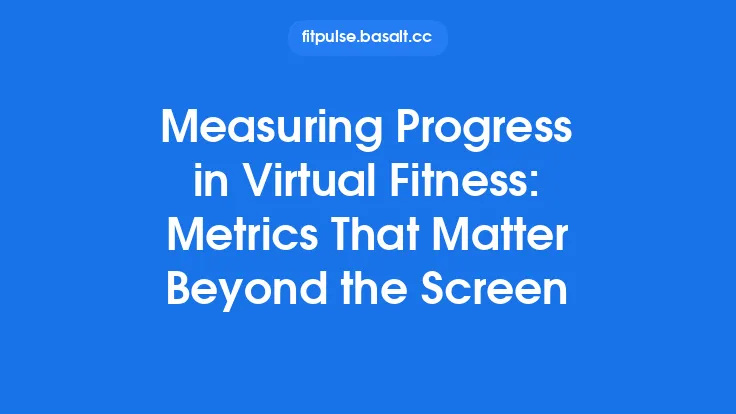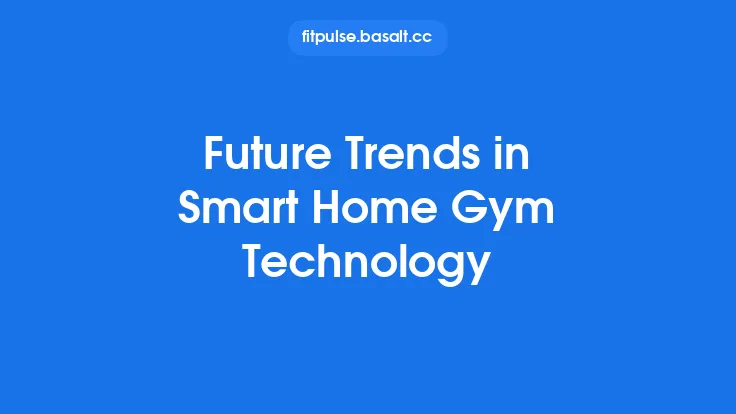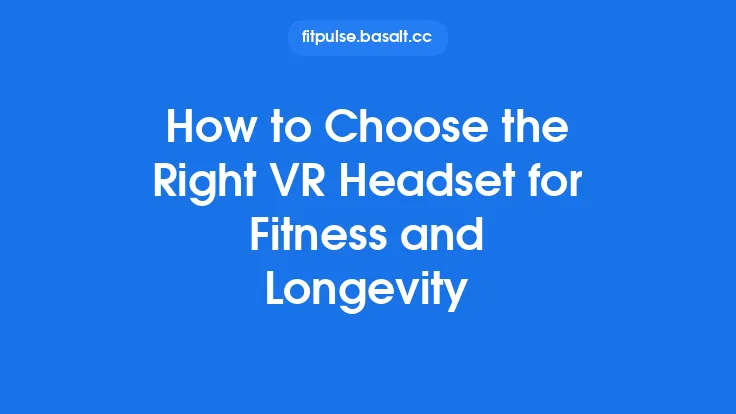The next decade promises to transform the way we move, train, and experience physical activity through virtual and augmented reality. While today’s VR/AR fitness solutions already offer immersive workouts, the convergence of several emerging technologies will push the boundaries far beyond simple “game‑like” sessions. From AI‑driven personalization and cloud‑based rendering to neuro‑responsive environments and seamless cross‑reality ecosystems, the future landscape will be defined by experiences that adapt in real time, connect users worldwide, and integrate deeper physiological signals—all while remaining accessible and sustainable. Below, we explore the most compelling trends that will shape VR/AR fitness from 2025 to 2035, outlining the technical foundations, potential use cases, and broader implications for the industry.
AI‑Powered Adaptive Coaching and Narrative Generation
Artificial intelligence is set to become the core engine behind next‑generation fitness experiences. Rather than relying on static workout scripts, AI coaches will continuously analyze a user’s biomechanical data, performance trends, and contextual cues (e.g., time of day, ambient lighting, user mood) to generate dynamic training narratives.
- Real‑time biomechanical modeling – Advanced computer vision combined with depth sensors will reconstruct a user’s skeletal motion in three dimensions, allowing AI to detect subtle form deviations and suggest micro‑adjustments on the fly.
- Procedural content generation – Narrative-driven environments (e.g., a futuristic city chase or a mountain‑climbing expedition) will be assembled algorithmically, ensuring each session feels fresh while still targeting specific training goals.
- Personalized progression curves – Machine‑learning models will predict optimal load, intensity, and recovery windows for each individual, adjusting difficulty in real time to maximize adaptation without overtraining.
These AI capabilities will shift the role of the virtual trainer from a pre‑programmed avatar to a truly responsive partner that evolves alongside the user.
Cloud‑Native Rendering and Edge Computing for Ultra‑Realistic Environments
High‑fidelity graphics have traditionally been limited by the processing power of standalone headsets. Over the next ten years, the migration of rendering workloads to the cloud and the proliferation of edge‑computing nodes will enable photorealistic worlds without sacrificing mobility.
- Hybrid rendering pipelines – Core scene geometry and physics will be processed locally, while texture streaming, lighting calculations, and complex particle effects are offloaded to nearby edge servers, reducing latency to sub‑10 ms thresholds.
- Dynamic bandwidth adaptation – Adaptive bitrate streaming will ensure smooth visual quality even on fluctuating wireless connections, automatically scaling resolution and frame rate based on network conditions.
- Scalable world persistence – Cloud‑backed world states will allow users to leave a virtual gym, return later, and find their equipment, progress, and environment exactly as they left it, fostering continuity across sessions and devices.
The result will be immersive spaces that feel as vivid as real‑world locations, encouraging deeper engagement and longer training durations.
Multi‑Modal Biofeedback Integration Beyond Simple Metrics
Future fitness platforms will ingest a richer tapestry of physiological signals, moving past basic heart‑rate or calorie counters to incorporate data streams such as electromyography (EMG), galvanic skin response (GSR), and even cerebral activity.
- EMG‑driven resistance modulation – By measuring muscle activation patterns, the system can dynamically adjust virtual resistance (e.g., making a virtual rowing paddle feel heavier when the user’s biceps are under‑engaged) to promote balanced development.
- GSR‑informed intensity scaling – Sudden spikes in skin conductance, often linked to stress or excitement, can trigger adaptive environmental cues—such as calming visual filters or intensified challenges—to keep the user in an optimal arousal zone.
- Neuro‑responsive environments – Emerging non‑invasive EEG headsets will allow the platform to detect focus levels, enabling the environment to subtly shift difficulty or provide motivational prompts when attention wanes.
These biofeedback loops will create a closed‑feedback system where the virtual world reacts to the body’s internal state, fostering a more holistic training experience.
Cross‑Reality (XR) Ecosystems and Interoperability
As the distinction between virtual, augmented, and mixed reality blurs, fitness experiences will increasingly span multiple device categories, allowing users to transition seamlessly between fully immersive VR, overlay‑based AR, and even spatial audio‑only sessions.
- Unified identity and progress layers – A single user profile will persist across VR headsets, AR glasses, and mobile devices, aggregating achievements, skill trees, and virtual gear in a cloud‑based ledger.
- Device‑agnostic content formats – Developers will adopt open standards (e.g., OpenXR, WebXR) to ensure that a workout designed for a high‑end tethered headset can be downscaled for a lightweight AR smartglass without losing core gameplay mechanics.
- Hybrid training scenarios – Imagine a session that begins with an AR warm‑up projected onto a real gym floor, transitions to a fully immersive VR sprint through a digital canyon, and concludes with a spatial‑audio meditation that can be experienced on any device.
Interoperability will break down silos, giving users the freedom to train wherever they are while preserving the continuity of their virtual fitness journey.
Spatial Audio Evolution and Holographic Soundscapes
While visual immersion often steals the spotlight, sound is a critical component of presence. Advances in spatial audio rendering will make auditory cues as precise and influential as visual ones.
- Object‑based audio rendering – Individual sound sources (e.g., a distant waterfall, a teammate’s footsteps) will be positioned in three‑dimensional space with accurate occlusion and reverberation, enhancing realism.
- Dynamic acoustic adaptation – The system will modify environmental acoustics in real time based on user actions (e.g., louder echo when sprinting in a canyon) to reinforce the perception of speed and effort.
- Physiological audio feedback – Subtle changes in pitch or timbre can be linked to biometric data, providing an intuitive “sonic dashboard” that informs the user of heart‑rate zones or muscle fatigue without visual clutter.
These auditory innovations will deepen immersion, improve situational awareness, and add an extra layer of motivational feedback.
Gamified Social Metaverses for Collaborative Fitness
Social interaction has always been a driver of engagement. The next generation of fitness metaverses will blend competitive and cooperative gameplay with robust social mechanics.
- Persistent guilds and training clans – Users can form long‑term groups that share virtual spaces, schedule joint sessions, and collectively unlock narrative arcs (e.g., rebuilding a virtual city through cumulative workout contributions).
- Live avatar embodiment – High‑fidelity motion capture will allow participants to see accurate, low‑latency representations of each other’s bodies, fostering a sense of co‑presence that mirrors real‑world group classes.
- Shared environmental manipulation – Teams can collaboratively modify the training environment (e.g., raising a virtual hill by collectively completing a set of squats), turning workouts into shared world‑building activities.
By embedding fitness within a living social ecosystem, motivation becomes a community‑driven experience rather than an isolated pursuit.
Neuro‑Responsive Training and Brain‑Computer Interfaces (BCIs)
The frontier of immersive fitness will extend into the realm of direct brain‑computer interaction, enabling training programs that respond to cognitive states as well as physical performance.
- Attention‑guided difficulty scaling – Real‑time EEG data can detect lapses in focus, prompting the system to introduce novel stimuli or adjust challenge levels to re‑engage the user.
- Cognitive load balancing – Complex motor tasks (e.g., coordinated dance routines) can be paired with mental challenges (e.g., memory puzzles) that adapt based on measured cognitive bandwidth, creating truly dual‑task training environments.
- Neuro‑plasticity enhancement – By synchronizing visual, auditory, and proprioceptive feedback with targeted brainwave patterns, developers can design sessions that promote motor learning and skill acquisition more efficiently.
While still emerging, BCIs hold the promise of turning fitness into a fully integrated mind‑body discipline.
Sustainable Hardware Design and Circular Economy Models
As VR/AR fitness adoption scales, manufacturers will need to address environmental impact through smarter design and lifecycle management.
- Modular headset architectures – Swappable components (e.g., lenses, battery packs, processing modules) will extend device longevity and reduce electronic waste.
- Recyclable composite materials – Biodegradable polymers and reclaimed carbon‑fiber composites will become standard, allowing end‑of‑life devices to be reclaimed with minimal environmental footprint.
- Subscription‑based hardware leasing – Users can opt for a “fitness‑as‑a‑service” model where hardware is periodically upgraded and responsibly recycled, aligning with the broader trend toward circular economies.
Sustainability will become a competitive differentiator, influencing purchasing decisions for both consumers and enterprise clients.
Inclusive Design and Adaptive Accessibility
Future VR/AR fitness platforms will prioritize inclusivity, ensuring that people of varying abilities, ages, and cultural backgrounds can fully participate.
- Customizable locomotion schemes – Options such as teleportation, seated movement, or eye‑gaze navigation will accommodate users with limited mobility or vestibular sensitivities.
- Multilingual, culturally adaptive narratives – Procedural story engines will generate content that respects regional customs, language preferences, and cultural motifs, making experiences feel locally relevant.
- Assistive sensor integration – Devices like adaptive switches, voice control, and haptic‑free feedback (e.g., visual or auditory cues) will enable users with sensory impairments to engage without reliance on excluded modalities.
By embedding accessibility at the core of design, the industry will broaden its reach and foster a more diverse user base.
Data Privacy, Ownership, and Ethical AI Governance
The deep integration of biometric and behavioral data raises critical concerns around privacy and ethical use. Over the next decade, robust frameworks will emerge to protect users while still enabling innovation.
- Decentralized identity wallets – Users will store personal data in encrypted, self‑custodial wallets, granting selective access to applications via verifiable credentials.
- Transparent AI audit trails – Fitness AI models will be required to log decision‑making processes, allowing users and regulators to audit how training recommendations are generated.
- Regulatory compliance layers – Platforms will embed compliance modules for standards such as GDPR, CCPA, and emerging health‑data regulations, ensuring cross‑jurisdictional data handling is lawful and ethical.
These safeguards will build trust, encouraging broader adoption of data‑intensive fitness solutions.
Conclusion: A Decade of Convergence and Human‑Centric Innovation
The trajectory of VR/AR fitness over the next ten years is defined not by a single breakthrough but by the convergence of multiple technological streams—AI, cloud rendering, biofeedback, spatial audio, social metaverses, neuro‑interfaces, sustainable hardware, and ethical data practices. Together, they will deliver experiences that are more personalized, immersive, socially connected, and responsibly designed than anything available today.
For developers, investors, and fitness professionals, the imperative is clear: embrace interdisciplinary collaboration, prioritize user‑centric design, and stay ahead of the evolving standards that will govern data, accessibility, and environmental impact. By doing so, the industry can unlock a future where virtual and augmented reality become not just novel workout tools, but integral partners in a holistic, lifelong journey toward health and well‑being.





